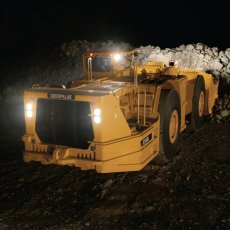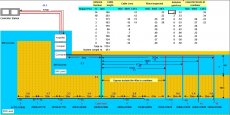BCD Resources - Beaconsfield Mine
An interesting project undertaken at BCD's Beaconsfield Gold Mine involved the design of transmission infrastructure for use with their Tele-Remote system.
A Tele-Remote system is one where a machine, in this case Elphinstone underground loaders (bogger), is controlled remotely by using a data and video stream fed back to an operator so he can control and see what is happening.
The project was undertaken because of a change in mining method and the implementation of stricter safety procedures.
Basically what happened; before mining operations or firing commenced, the cabling infrastructure was run out and antennas attached and mounted securely in the drive where the bogger was to operate. There was also an imperative here which meant that everything had to work well first up, because once the stope was fired no one was allowed back into the area. Remote operation only...
The first step for us was to visit the mine and see what the conditions were and get an understanding of what the miners were trying to achieve.
The plan was to run out an antenna system in a drive running parallel to the area being mined by drilling holes through a wall at strategic intervals through which antenna cables were passed. On one side of the wall antennas where connected, on the other the cable was connected to a main feed line, for which we used ANDREWS LDF4-50 Heliax cable. The feed line was fed back to the remote bogger operator's cuddy some 450 meters away. Running along side the heliax was a length of CAT5E cable which was used to connect a video monitor at the bogger control cuddy and a camera located at the brow of the stope. The camera enabled the operator to see when the bogger was getting too close to the brow.
Because there was a fair amount of drilling required, we needed to predict with reasonable accuracy the how much radio signal would be available from each antenna point. This was done using MS EXCEL to develop a calculator which worked out the distances and signal levels between each of the drill holes.
The final hurdle was the need to withdraw both the antenna and the camera from the face to prevent damage when the stope was fired. Tele-Remote systems normally use beam antennas (yagi). In this instance yagi antennas were unsuitable for the purpose. We needed a collinear style antenna (broom stick shaped). We approached MOONRAKER antennas in Hobart who developed an aerial which was efficient in the 471 MHz and operated well in the 540-674 mHz band. The antenna was mounted inside conduit to enable it to be manoeuvred through the drill holes. The stoping camera was also mounted in a conduit housing which had threaded sections of 25mm conduit attached along which the camera cable was routed. Sections of conduit where added or removed as required.
The system was used successfully for many months until mining methods again changed and it's use was no longer required...


